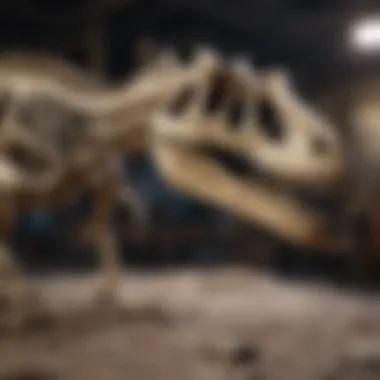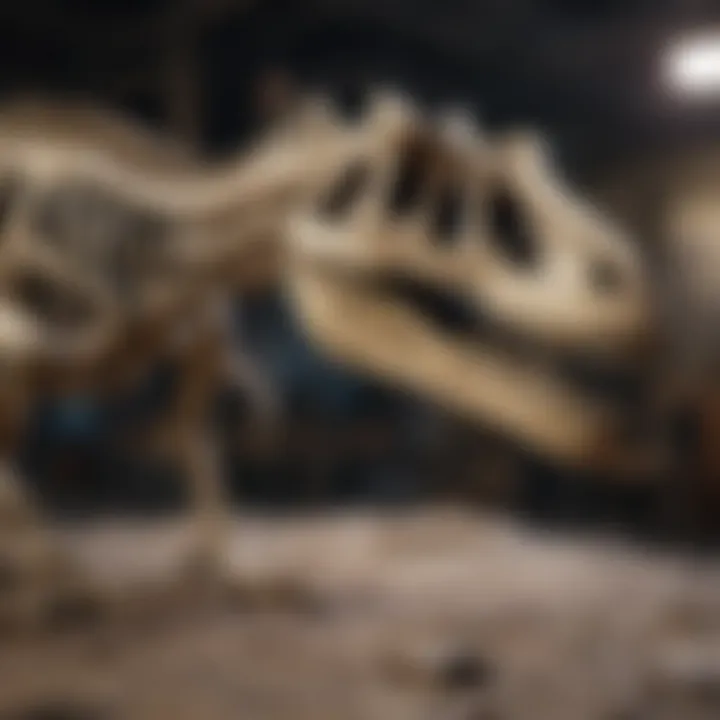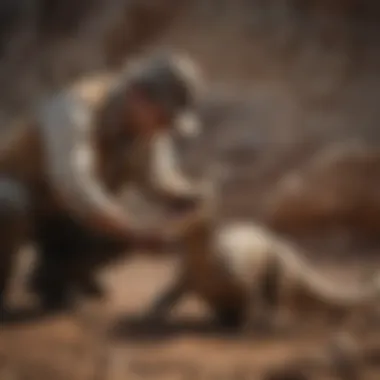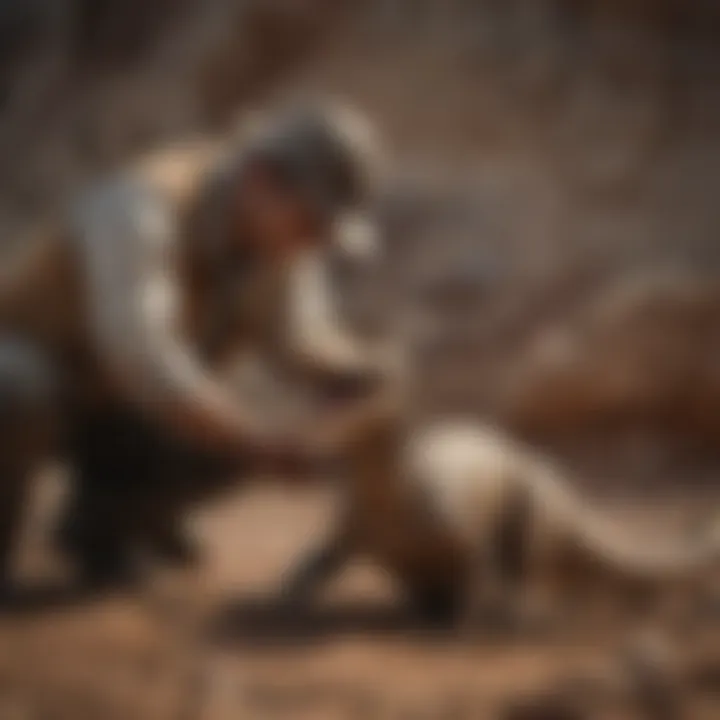Fossilized Dinosaurs: Unveiling Earth's Ancient Secrets


Intro
Fossilized dinosaurs present a remarkable window into the distant past, offering insights into life forms and ecosystems that existed millions of years ago. The process of fossilization is not merely a result of chance; it requires specific conditions that allow organic materials to be preserved. Understanding these ancient species and their environments enhances our knowledge of Earth’s history and evolution.
Researchers in paleontology dedicate their careers to uncovering these remnants, applying various techniques to study and interpret their findings. Collectors also play a significant role in the appreciation of dinosaur fossils, expanding the reach of this scientific endeavor beyond academic circles. This exploration serves not only to highlight the historical significance of dinosaur fossils but also to demystify their collection and care.
Featured Collectible of the Month
Overview
This month, we feature a rare specimen of Tyrannosaurus rex teeth, sought after for their size and archeological significance. Found in the Hell Creek Formation in Montana, these fossils have provided invaluable information regarding the feeding habits and physical capabilities of one of history's most formidable predators. These teeth, measuring up to 12 inches long, are a collector's dream due to their impressive scale and recognizable shape.
Historical Significance
The significance of Tyrannosaurus rex extends beyond its fearsome appearance. This species is a cornerstone of paleontological research, representing a key part of the Cretaceous period ecosystem. Studying T. rex teeth allows scientists to infer dietary preferences and hunting strategies. The connection between these fossils and their respective geological formations illustrates how ancient species adapted to their environments.
"The discovery of dinosaur fossils, like those of T. rex, has transformed our understanding of prehistoric life, shaping the narratives we weave about evolutionary biology and extinction events."
Identification Techniques
Visual Characteristics
Identifying dinosaur fossils involves careful examination of their physical traits. Key characteristics to look for include:
- Shape and Size: Fossils vary widely; teeth, bones, and claws all have specific forms distinctive to each species.
- Surface Texture: Many fossils have unique textures that hint at their origins. Fine striations, for instance, can indicate certain types of dinosaur teeth.
- Coloration: Colors can often provide clues about the fossil's age and the conditions under which it was preserved.
Resources for Identification
For collectors and enthusiasts, several resources can assist in identifying dinosaur fossils:
- Wikipedia: Extensive entries on various dinosaur species and fossils. Wikipedia
- Britannica: Comprehensive articles about paleontology and fossilization processes. Britannica
- Discussion Forums: Platforms such as Reddit allow for community interaction and sharing of knowledge about fossil identification. Reddit
- Social Media Groups: Facebook hosts several groups where collectors can share finds and seek identification assistance. Facebook
In summary, fossilized dinosaurs are more than mere remnants of the past. They are rich sources of knowledge, capturing the essence of an era long gone. Understanding their significance and learning proper identification techniques can broaden one’s appreciation for these ancient treasures.
Prolusion to Fossilized Dinosaurs
Fossilized dinosaurs offer remarkable insights into our planet's distant past. Understanding these remnants illuminates not just the species that once roamed the Earth but also the environmental conditions and evolutionary processes that shaped their development. This section will explore the significance of dinosaur fossils, emphasizing their role in paleontology and the broader implications for science and education.
Defining Fossils
Fossils are the preserved remains or traces of ancient organisms. They provide critical evidence of the biological history of life on Earth. The most well-known fossils are bones, though fossils can also include non-bone materials, such as teeth, footprints, and even imprints of skin or feathers. Fossils form through several processes, which can preserve the original structure of an organism or leave behind mere traces of its existence.
Fossils are categorized into various types based on their formation and preservation method. For instance, body fossils are the physical remains of an organism, while trace fossils include evidence of behavior, like footprints or burrows. Understanding these distinctions is essential for paleontologists when they deduce the behaviors and environments of ancient species, particularly dinosaurs.
Understanding Dinosaurs
Dinosaurs belonged to a diverse group of reptiles that dominated Earth during the Mesozoic Era, spanning approximately 180 million years. The study of dinosaurs focuses on their classification, biology, and the circumstances leading to their extinction, which occurred around 66 million years ago.
Dinosaurs are commonly divided into two major groups: the Saurischia, which includes theropods like Tyrannosaurus rex, and the Ornithischia, which involves species such as Stegosaurus. Each group displays unique characteristics that reflect their adaptations to different environments. For example, theropods were typically bipedal and predatory, while ornithischians often had herbivorous diets and varied locomotion.
The significance of understanding dinosaurs extends beyond mere classification. These creatures serve as critical indicators of prehistoric ecological systems. Their study helps scientists decipher evolutionary relationships and responses to climatic changes, offering clues about our own planet's future.
"Fossils act as a time capsule, preserving evidence of life that helps us understand the past."
The Discovery of Dinosaur Fossils
The discovery of dinosaur fossils stands as a cornerstone in our understanding of Earth’s history. These remnants not only tell the tale of the magnificent creatures that once roamed the planet but also provide invaluable insights into the biological and ecological dynamics of prehistoric eras. Tracking the origins and development of paleontology informs collectors and enthusiasts about the broader context in which these fossils exist. Knowing how fossils were unearthed can enhance appreciation for their significance and foster a deeper respect for ongoing research in this field.
Historical Milestones in Paleontology
Paleontology has a rich history that is marked by significant discoveries and developments. One of the earliest mentions of dinosaur fossils occurred in the early 19th century with the formal description of Megalosaurus by Richard Owen in 1824. Owen was instrumental in coining the term "Dinosauria" in 1842. His work set the foundation for future paleontological studies and helped shape our understanding of these ancient reptiles.
Another pivotal moment came with the excavation of Hadrosaurus in North America, which was notably one of the first nearly complete dinosaur skeletons found in the mid-19th century. This discovery garnered public interest and transformed views on dinosaurs, showcasing them as a significant part of Earth's history rather than mere myth.
These milestones indicate the evolving methodology of fossil exploration. Being aware of the timeline and key figures in paleontology can enhance a collector's understanding of the significance behind certain fossils and their provenance.


Significant Fossil Sites
Numerous fossil sites around the world have garnered attention for their richness and significance. One prominent location is the Hell Creek Formation in Montana, USA, famous for its diverse Late Cretaceous dinosaur fossils, including Tyrannosaurus rex and Triceratops. The fossil abundance at this site has made it a focal point for paleontological research and a source of captivating discoveries.
Another notable site is the Liaoning Province in China. The deposits here, dating back to the Early Cretaceous period, have produced exceptionally preserved fossils, including feathered dinosaurs. This site's discoveries have sparked debates about the evolution of birds and their relationship to dinosaurs, highlighting the intricate connections within ancient ecosystems.
Furthermore, the Gobi Desert, encompassing parts of Mongolia and China, has been pivotal in uncovering fossils such as Velociraptor. The harsh conditions of the desert have surprisingly provided a unique environment for preservation, revealing information about these creatures' morphology and behavior.
Each of these significant sites contributes to the collective narrative of dinosaurs, illustrating their diversity and adaptation. They also remind current collectors of the history encapsulated within each fossil, reflecting a story millions of years in the making.
Fossilization Processes
Fossilization processes are essential in understanding how dinosaurs become preserved in the geological record. The different methods of fossilization influence the type and quality of fossils that can be found and studied. Knowing these processes helps paleontologists interpret the past accurately. Variation in fossilization also indicates the environments where these creatures lived. Understanding fossilization aids in reconstructing ancient habitats and biodiversity.
Types of Fossils
Fossils can be categorized into several types. Each type offers unique insights into an organism's life and environment. Some common types include:
- Body Fossils: These include bones, teeth, and shells. They represent the actual physical remains of dinosaurs.
- Trace Fossils: These are indirect signs of life, such as footprints or burrows. They provide information about behavior and movement.
- Molecular Fossils: Indications of biological molecules from ancient organisms, sometimes preserving DNA, can be found in sedimentary environments.
These classifications help scientists interpret the life of dinosaurs and their ecosystems.
Mechanisms of Fossilization
Fossilization occurs through various mechanisms that influence how remains are preserved.
Permineralization
Permineralization is a prevalent method where minerals fill the pores of organic material like bones. This process effectively turns the material into stone while preserving its original structure. Key characteristics of permineralization include:
- Detail Preservation: It retains fine details of the organism's structure.
- Durability: Fossils formed through this method are often resilient to degradation.
- Commonality: Many dinosaur fossils exist due to this effective mechanism.
While permineralization is beneficial for preserving structural details, it has limitations. It relies on specific conditions such as rapid burial in mineral-rich sediment, which might not always occur.
Carbonization
Carbonization involves the transformation of organic material into a thin film of carbon. This occurs when temperatures and pressures rise over time. The key aspects of carbonization are:
- Simplicity: The preservation process is straightforward and does not require extensive burial as seen in permineralization.
- Lightweight Representations: The resulting fossils may be lighter and less substantial than those formed by other processes.
However, carbonization leads to a loss of three-dimensional structure. As a result, detail may be compromised, making it less informative for certain studies.
Amber Preservation
Amber preservation occurs when organisms become trapped in tree resin, which hardens over time. This mechanism is unique because:
- Exceptional Preservation: It can preserve not just bones but soft tissues, insects, and even DNA.
- Ecological Snapshots: Fossils in amber provide snapshots of ecosystems from the past, including color and morphology.
Despite its advantages, amber preservation is rare. It typically favors small organisms, and therefore the majority of dinosaur fossils do not result from this process.
The processes of fossilization contribute to our understanding of dinosaurs and their environments. By studying the different types and preservation mechanisms, researchers gain essential insights into the Earth’s ancient past.
Key Discoveries in Dinosaur Fossils
Key discoveries in dinosaur fossils provide crucial insights into the history of life on Earth. They allow paleontologists to piece together the ancient ecosystems in which these creatures once thrived. The study of these fossils has not only revolutionized our understanding of dinosaurs but also contributed significantly to evolutionary biology and paleontology as a whole. By investigating notable fossil finds, researchers create a clearer picture of how dinosaurs lived, interacted, and evolved over millions of years, influencing modern biological research.
Notable Dinosaur Species
Numerous dinosaur species have been identified through fossil discoveries, each contributing unique information about dinosaur diversity and behavior. For instance, Tyrannosaurus rex stands out as one of the most studied species due to its size and predatory nature. Fossils of this species have revealed details about its hunting techniques and social structure. Another significant species, Triceratops, has lent insight into herbivore behavior and the ecological roles these creatures played. Fossils showing the physical adaptations of these species help scientists understand their environmental interactions.
Moreover, some lesser-known species like Therizinosaurus showcase peculiar traits, such as elongated claws, which challenge previous notions about dinosaur functionality. These findings emphasize that dinosaur evolution is not a linear process; it is diverse and complex.
Fossils That Changed Our Understanding
Several fossil discoveries have fundamentally shifted the perspectives held about dinosaurs. One such discovery is the Archaeopteryx, which showcased feathers in what was once thought to be a strictly terrestrial lineage. This fossil supports the theory that birds are descended from theropod dinosaurs, blurring the lines between these two groups in the evolutionary tree.
Another pivotal fossil is the Maiasaura, which provided evidence for parental care and nesting behavior among dinosaurs. This finding challenged the previously dominant view of dinosaurs as solitary creatures. The realization that some species might have exhibited social behaviors reshapes our understanding of their lifestyles and survival strategies.


"Fossil discoveries continually reshape our understanding of ancient life and its complexities."
In summary, key discoveries in dinosaur fossils serve as essential evidence in piecing together the life forms that once roamed our planet. They offer revelations about species adaptations, behavior, and ecological relationships, contributing to an evolving narrative in the field of paleontology. Such discoveries not only excite the scientific community but also engage rock and fossil collectors who value the significance these ancient artifacts hold in understanding Earth's rich biological history.
Paleontological Techniques
Paleontological techniques are crucial for understanding the history of dinosaur fossils. These methodologies not only guide the excavation of specimens but also help in their analysis. They bridge the gap between mere discovery and comprehensive interpretation of fossils, allowing scientists to piece together the past with detail and accuracy. Without these techniques, the potential for learning from individual finds would greatly diminish.
Excavation Methods
Excavation methods are the foundational tools used in paleontology. They involve the careful process of digging up fossilized remains from the earth. Traditional methods include using hand tools, like trowels and brushes, to avoid damaging delicate fossils. These techniques require patience and precision.
Innovations such as ground-penetrating radar and 3D scanning also play a significant role today. These technologies enable paleontologists to visualize the site before excavation begins. They help prevent unnecessary disturbance to surrounding soil layers, preserving the geological context of the finds. This context is important as it offers clues about the environment in which the dinosaurs lived. Modern excavations often integrate traditional techniques with these advanced tools for the best results.
Laboratory Analysis
Laboratory analysis is essential for studying the fossils after they are excavated. It involves various techniques that provide insight into the biological and ecological characteristics of the specimens.
Radiographic Imaging
Radiographic imaging is a critical tool in the analysis of fossils. This method uses X-rays to create images of the internal structures without damaging them. A key characteristic of radiographic imaging is its ability to reveal details that are not visible to the naked eye. This makes it a beneficial choice for understanding the anatomy of fossils and for detecting any hidden features.
One unique feature of radiographic imaging is its non-invasive nature. This means paleontologists can study fragile or rare fossils while maintaining their integrity. However, organizing and interpreting images can be complex, which is a disadvantage when precise details are needed. Overall, this approach plays an essential role in advancing our knowledge of fossilized remains.
Isotope Analysis
Isotope analysis examines the ratios of stable isotopes within fossil materials. This technique provides information related to the age of fossils and the environmental conditions during their formation. A main characteristic of isotope analysis is its ability to inform scientists about dietary habits and climate. It is a favored method in paleontology because it adds depth to the understanding of dinosaur ecosystems.
The Importance of Dinosaur Fossils
Dinosaur fossils serve as vital windows into the past, contributing significantly to our understanding of life on Earth. The study of these fossils allows scientists and enthusiasts to piece together the history of evolution, enabling a clearer picture of how environments and life forms have transformed over millions of years. Understanding this aspect enriches both the scientific community and the public's appreciation of natural history.
One critical element of dinosaur fossils is their role in uncovering insights into evolutionary biology. By examining different fossilized species, paleontologists grasp how various traits evolved over time in response to environmental pressures. The physical characteristics preserved in fossils provide evidence for evolutionary changes, illustrating the adaptive strategies of dinosaurs. For instance, the discovery of theropod dinosaurs demonstrated links to modern birds, reshaping our perception of the evolutionary narrative.
Insights into Evolutionary Biology
Examining dinosaur fossils reveals important evolutionary patterns. Fossils capture moments of adaptation and extinction, illustrating life’s complexities.
Evidence from fossils also supports theories about the origins of species, their migration patterns, and genetic evolution over time. Through comparative analysis, researchers can determine how certain features evolved, such as the development of feathers or the adaptations for predation.
- Natural Selection: Dinosaur fossils provide proof of natural selection at work. Characteristics that favored survival are often reflected in the fossil record.
- Diversity: Fossils show the vast diversity of dinosaur species that existed, shedding light on the ecological niches they occupied.
This analysis fosters an understanding of extinction events, an area that attracts considerable interest. By studying the fossils predating and following mass extinctions, one can draw connections to environmental factors that influenced survival.
Understanding Ancient Ecosystems
Dinosaur fossils are instrumental in reconstructing ancient ecosystems. They indicate the types of plants and animals coexisting in the same environment, and help scientists determine climate conditions from geological evidence.
- Paleoecology: Understanding the interactions of different species within ecosystems provides insights into competition and predator-prey relationships.
- Geological Context: The locations of fossil finds often correlate with specific geological formations. This relationship informs about continental shifts, climate changes, and habitat diversity over geological time.
"Each fossil discovered is like a piece of a puzzle, revealing a picture of life in an ancient world."
By piecing together these vital components, paleontologists work to describe ancient habitats. Identifying plant life from fossilized remains also helps confirm the vegetation that supported various dinosaur species.
In this way, dinosaur fossils are not just remnants of past creatures, but essential artifacts that advance our understanding of life's history, evolutionary biology, and ecological dynamics. The study offers critical knowledge that informs everything from conservation efforts to the understanding of climate change today.
Care and Preservation of Fossils
The care and preservation of fossils is a pivotal topic in paleontology. It ensures that these remnants of earth’s history can be studied, appreciated, and utilized for educational purposes. The fossil record offers vital insights into past life, environments, and climatic shifts. Therefore, preserving fossils not only benefits scientific inquiry but also contributes to the understanding of evolutionary processes.
Fossils, fragile by nature, often face numerous threats. Natural degradation, environmental factors, and mishandling can hamper their integrity. Thus, effective strategies are necessary to mitigate these risks. In the sections below, the challenges in preservation and best practices for collectors will be discussed in depth.
Challenges in Preservation
Fossils encounter several challenges that impact their preservation. Some of the primary issues include:


- Environmental Factors: Temperature, humidity, and exposure to light can all affect fossil integrity. High humidity may promote mold growth, while excessive dryness can lead to cracking.
- Chemical Reactions: Many fossils contain minerals that can react unfavorably with surrounding substances. Acidic conditions, for instance, may dissolve delicate components, leading to loss of detail and clarity.
- Physical Damage: Fossils may suffer from improper handling. Simple errors such as dropping or even touching with bare hands can lead to irreparable harm.
- Pests and Microorganisms: Organisms like insects and bacteria can compromise fossils if not appropriately managed, leading to degradation over time.
These challenges underscore the need for careful management and a systematic approach to fossil care. Collectors and institutions alike must adopt effective preservation techniques to protect these valuable relics.
Best Practices for Collectors
For both amateur and professional collectors, understanding best practices in fossil care is essential. The following guidelines can help ensure the longevity and stability of fossil specimens:
- Controlled Environment: Store fossils in a cool, dry place. Temperature fluctuations should be minimized to avoid expansion and contraction that might cause damage.
- Use of Protective Materials: When displaying or storing fossils, use acid-free materials. Foam, felt, and specialized boxes can help cushion and protect specimens from physical harm.
- Avoid Direct Contact: Use gloves to handle fossils. Skin oils can degrade the surface and attract contaminants. Furthermore, consider using tools designed for fossil handling whenever possible.
- Regular Monitoring: Periodically check on stored fossils to ensure no signs of deterioration are present. Early detection can mitigate potential damage significantly.
- Document Everything: Maintain detailed records of each specimen, including location, condition, and any changes observed over time. This information can be invaluable for ongoing care and research.
By abiding by these practices, collectors can contribute to the preservation of fossil history for future study and appreciation.
Effective fossil preservation not only protects the specimens themselves but also safeguards the invaluable knowledge they offer about the past.
Collecting Dinosaur Fossils
Collecting dinosaur fossils represents a fascinating convergence of science, history, and personal passion. For many, it is not just a hobby but a pursuit that provides a tangible connection to the Earth's distant past. Engaging in fossil collecting can lead to numerous benefits, such as enhancing one's knowledge of paleontology, understanding geological formations, and fostering a deep appreciation for biodiversity throughout history. However, diving into this world is not without its complexities and ethical considerations.
Legal Considerations
Before embarking on fossil collection, one must navigate the legal framework governing the practice. Laws vary widely by region, affecting who can collect fossils and where. In some places, like the United States, fossils found on private land may be collected by the landowner, while fossils on public land typically require permits.
- Understand Local Regulations: Always familiarize yourself with the laws in your area. For example, the Bureau of Land Management has rules specific to fossil collection in the United States.
- Permits may be Necessary: Some locations require permits to collect fossils, especially in sensitive ecological or historical sites. Ignoring these legal requirements can lead to heavy fines.
- Respect the Environment: It is crucial to avoid damaging the sites from which fossils are collected. Environmental conservation laws are in place to protect paleontological resources.
"Fossils are a window to the past; collecting them should be done responsibly to ensure future generations can also explore Earth's history."
Finding Authentic Dinosaur Fossils
Finding authentic dinosaur fossils can be both exhilarating and challenging. Numerous factors come into play when searching, from knowing the right locations to understanding how to identify a true fossil.
- Research Locations: Areas known for dinosaur fossils include the Hell Creek Formation in Montana and the Morrison Formation across several Western states. These sites have a rich history of fossil discoveries.
- Engage with Communities: Many online forums and local clubs exist where enthusiasts share tips and locations. Websites such as Reddit and Facebook have groups dedicated to fossil hunting.
- Use Proper Tools: Gear such as hand tools, brushes, and bags can assist in careful excavation. An eye for detail is essential; not every stone is a fossil, but some may hide a treasure beneath.
In summary, collecting dinosaur fossils is a rewarding endeavor that comes with important legal and ethical responsibilities. By understanding the laws, respecting the environment, and knowing where to search, collectors can contribute to the ongoing story of our planet's ancient inhabitants.
Contemporary Debates in Paleontology
The field of paleontology is ripe with discussions that reflect the evolving nature of science and society. Contemporary debates often revolve around the intersection of conservation and scientific research, as well as the increasing role of technology in studying fossils. These topics are crucial for understanding how paleontologists approach the analysis and preservation of dinosaur fossils today.
Conservation vs. Scientific Research
One of the major debates faced by paleontologists today is the balance between conservation efforts and scientific investigation. On the one hand, there is a growing awareness of the need to protect fossil sites. These sites are often threatened by industrial activities, climate change, and urban development. The preservation of these locations is vital for future studies and for maintaining biodiversity.
However, this conservation ethos can conflict with research needs. Scientists require access to certain fossil sites in order to conduct studies that could yield new insights into paleobiology, evolution, and ecology. Some argue that without excavating these sites, we lose valuable information that informs our understanding of prehistoric life.
"The challenge lies in finding a balance that allows for the study and enjoyment of fossils without depleting their resources."
This debate highlights the necessity of creating policies that protect fossil-rich areas while still permitting scientific discovery. Collaborative efforts between conservationists and researchers can lead to sustainable practices that benefit both science and preservation.
The Role of Technology in Fossil Study
Advancements in technology have significantly impacted how fossil studies are conducted. Modern techniques enable researchers to analyze fossils with higher precision and reduced damage to the specimens. For example, methods such as computed tomography (CT) scanning allow scientists to view the internal structure of fossils without the need for physical preparation.
Furthermore, digital modeling and three-dimensional printing have provided new avenues for reconstructing ancient creatures. This technology not only aids in visualization but also plays a vital role in educational outreach and public engagement. More people can access accurate representations of dinosaurs and their environments, fostering interest in scientific inquiry.
Recent innovations, such as laser scanning and drone surveys, allow for detailed mapping of fossil locations. This technology helps in locating new excavation sites and documenting existing ones without physical interference.
In summary, contemporary debates in paleontology address vital issues regarding the preservation of fossil sites and the utilization of cutting-edge technology. Understanding these discussions helps collectors, researchers, and enthusiasts appreciate the complex dynamics at play. This aligns with the broader goal of safeguarding our planet's natural history while promoting scientific advancement.
Culmination
The examination of dinosaur fossils offers an invaluable perspective on both the past and present. It deepens our understanding of not only ancient life but also evolutionary processes that have shaped the Earth over millions of years. The study of these fossils allows scientists to piece together the puzzle of prehistoric ecosystems, providing insights that inform both current biology and conservation efforts today.
The Future of Dinosaur Fossil Studies
Looking ahead, the field of dinosaur fossil studies is poised for exciting developments. Advances in technology, particularly in imaging and DNA analysis, are enhancing our capacity to understand these ancient creatures. For example, techniques such as high-resolution X-ray CT scans facilitate detailed reconstructions of fossilized remains, allowing for intricate studies without damaging the original specimens.
Moreover, interdisciplinary collaborations are becoming more common. Paleontologists are increasingly working with ecologists, geologists, and even artists to bring a holistic view of what dinosaurs were like and how they interacted with their environments. This kind of teamwork may lead to groundbreaking discoveries about dinosaur behavior or their response to climate changes.
In terms of preservation, efforts are being made to mitigate the impacts of climate change on fossil sites. Conservation strategies that combine both scientific inquiry and heritage management are essential. Protecting these sites not only preserves the fossils but also the context in which they are found, which is vital for future studies.
Also, public engagement through educational programs and exhibits encourages a greater appreciation of paleontology and its importance. This can inspire the next generation of researchers and collectors, ensuring that the legacy of dinosaur fossils continues.
In summary, the future of dinosaur fossil studies is bright, driven by technological advancements, interdisciplinary cooperation, and a commitment to conservation. Continuing this work will shed more light on the mysteries surrounding these incredible creatures and their ecosystems.



